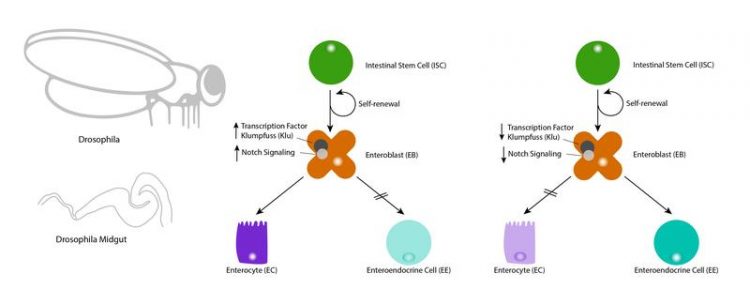How intestinal cells renew themselves – the role of Klumpfuss in cell differentiation

The transcription factor Klumpfuss (Klu) together with Notch signaling regulates cell differentiation of adult stem cells in the intestine of the fruit fly (Drosophila melanogaster) (Graphic: Magdalena Voll / FLI)
Stem cells react to tissue damage with an increase in their proliferation rate, leading to the production of new differentiated cells. Balance between cell loss and cell renewal through strict control of stem cell division guarantees the maintenance of organ size and function.
Precise control of differentiation in adult stem cell lines is important for the development and maintenance of tissue homeostasis. Stem cell dysfunction can disturb this process, which can lead to tissue degeneration and cancer.
The researchers studied the differentiation of adult stem cells during tissue homeostasis in the midgut of the fruit fly (Drosophila melanogaster) because it bears many similarities with the human gastrointestinal tract in both structure and function.
Injuries or infections lead to damage of the intestinal mucosa, which results in an increase in proliferation and differentiation of the intestinal stem cells (ISCs) to replace damaged cells and restore homeostasis.
Disruption of normal cell differentiation leads to impairment of intestinal function, as can be observed in the aging intestine. How cell differentiation is exactly regulated has not been known yet.
Researchers of the Leibniz Institute on Aging – Fritz Lipmann Institute (FLI) in Jena, Germany, together with colleagues of the Buck Institute for Research on Aging in Novato, USA, have identified a novel player in the regulation of cell renewal and differentiation in the midgut of the model organism Drosophila.
“With its stem cells, the intestine is able to regenerate itself continuously and to ensure the function and integrity of the tissue during the lifespan of an organism”, says Dr. Jerome Korzelius, first author of the study published in Nature Communications.
Asymmetric cell division of intestinal stem cells
Asymmetric division of ISCs is crucial for the process of cell renewal. An ISC renews by dividing into another stem cell and an enteroblast (EB) daughter cell. This daughter cell can then differentiate into two different types of differentiated cells depending on signaling cues: absorptive enterocytes (EC), cells that take up nutrients and are responsible for immune defense or enteroendocrine cells (EE) that produce gastrointestinal hormones. Recent work has shown that lineage choice in these EB daughter cells is likely more complex than previously thought.
Transcription factor Klumpfuss as regulator
The researchers discovered that the transcription factor Klumpfuss (Klu), which is related to the mammalian tumor-suppressor gene “Wilms’ Tumor 1” (WT1), plays an important role in the adult Drosophila midgut for the lineage choice of EBs. “We found Klu to be expressed specifically in EBs to regulate cellular differentiation towards the enterocyte lineage”, tells Dr. Korzelius, who is currently working at the Max Planck Institute for Biology of Ageing in Cologne, Germany. Klu suppresses the differentiation of enteroendocrine cells from EBs by downregulating genes necessary for EE differentiation. Therefore, a loss of Klu in the enteroblasts leads to differentiation of EBs in EE cells.
Interplay with Notch signaling
Furthermore, the researchers found that Klu and Notch signaling together play a role in ISC division and differentiation. ISCs produce the Notch-ligand Delta and activate Notch in the enteroblast daughter cell, the precursor of mature enterocytes.
Loss of Notch in ISC lineages leads to the development of tumors, likely because of impaired EB differentiation that leads to an increased frequency of symmetric divisions and excess EE differentiation. During EB differentiation, the transcription factor Klu acts to control Notch target gene expression. This control of Notch target genes by Klu adds another layer of regulation to this complex pathway, which is also important in many diseases in humans.
“Our results give a mechanistic insight into how cell differentiation in the Drosophila intestine is regulated”, summarizes Dr. Heinrich Jasper, senior author of the study. These are important insights into the control mechanisms of tissue regeneration that are also relevant for mammals, including humans.
Publication
The WT1-like transcription factor Klumpfuss maintains lineage commitment of enterocyte progenitors in the Drosophila intestine. Korzelius J, Azami S, Ronnen-Oron T, Koch P, Baldauf M, Meier E, Rodriguez-Fernandez IA, Groth M, Sousa-Victor P, Jasper H. Nat Commun. 2019 10(1), 4123. doi: 10.1038/s41467-019-12003-0.
Contact
Magdalena Voll
Press and Public Relations
Phone: 03641-656373, Email: presse@leibniz-fli.de
The WT1-like transcription factor Klumpfuss maintains lineage commitment of enterocyte progenitors in the Drosophila intestine. Korzelius J, Azami S, Ronnen-Oron T, Koch P, Baldauf M, Meier E, Rodriguez-Fernandez IA, Groth M, Sousa-Victor P, Jasper H. Nat Commun. 2019 10(1), 4123. doi: 10.1038/s41467-019-12003-0.
http://www.leibniz-fli.de – Website Leibniz Institute on Aging – Fritz Lipmann Institute Jena (FLI)
Media Contact
All latest news from the category: Life Sciences and Chemistry
Articles and reports from the Life Sciences and chemistry area deal with applied and basic research into modern biology, chemistry and human medicine.
Valuable information can be found on a range of life sciences fields including bacteriology, biochemistry, bionics, bioinformatics, biophysics, biotechnology, genetics, geobotany, human biology, marine biology, microbiology, molecular biology, cellular biology, zoology, bioinorganic chemistry, microchemistry and environmental chemistry.
Newest articles

Silicon Carbide Innovation Alliance to drive industrial-scale semiconductor work
Known for its ability to withstand extreme environments and high voltages, silicon carbide (SiC) is a semiconducting material made up of silicon and carbon atoms arranged into crystals that is…

New SPECT/CT technique shows impressive biomarker identification
…offers increased access for prostate cancer patients. A novel SPECT/CT acquisition method can accurately detect radiopharmaceutical biodistribution in a convenient manner for prostate cancer patients, opening the door for more…

How 3D printers can give robots a soft touch
Soft skin coverings and touch sensors have emerged as a promising feature for robots that are both safer and more intuitive for human interaction, but they are expensive and difficult…





















